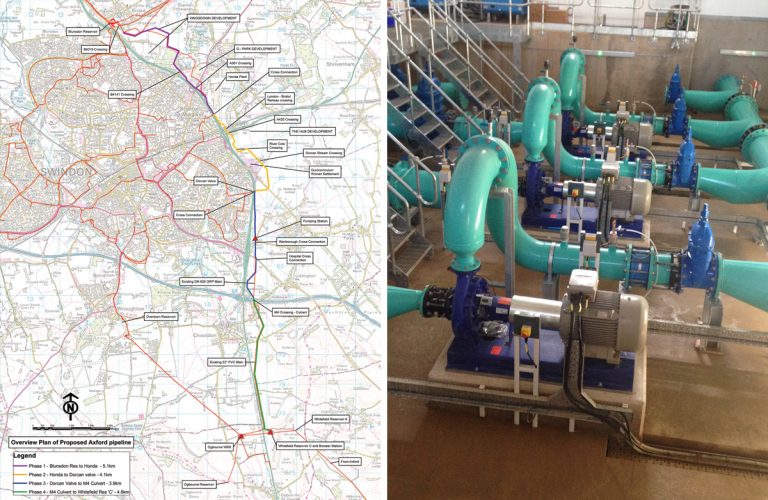Axford & Ogbourne WTWs (2017)

Recovery of TBM following completion of UTX - Courtesy of SMB
Thames Water Utilities Ltd (TWUL), in consultation with the Environment Agency (EA) committed to cease Kennet Aquifer abstraction at Ogbourne WTW and reduce abstraction at Axford WTW by 31st March 2017. The Ogbourne licence has been reduced to zero whilst the Axford licence has been changed to a sliding scale dependent on flows in the River Kennet. When in constraint (less than 100Ml/d) as measured by the EA at Knighton Gauging station, the Axford licence will be limited to 6Ml/d peak and average. This equates to a total reduction in deployable output of 7.5Ml/d average and 10.6Ml/d peak.
Introduction and overview
The deficit in water resource required an alternative supply which will be transferred from the north of the water resource catchment from Blunsdon Reservoir, supplied from Farmoor WTW via Faringdon Water Booster Station (WBS), to the Whitefield Reservoir complex south of Swindon, Wiltshire. This will be via a new 17.6km pipeline and three new booster stations, one of which being a complete new build site for TWUL near to Wanborough. An overview of the pipeline route and WBS locations is shown in figure 1 below.

(left) Figure 1: Overview of pipeline route and key locations and (right) Marsh Water Booster Station pump manifold – Courtesy of SMB
The scheme was one of the first major pipeline projects to be delivered through eight2O, an alliance formed to deliver capital investment works for TWUL through AMP6. SMB (Skanska, MWH Treatment and Balfour Beatty), one of the two joint ventures within eight2O, were responsible for delivering the scheme and acted as both principal designer and principal contractor.
The scheme was tendered under a series of works packages, with the main contracts being let to O’Connor Utilities Ltd for the pipeline and civils, and Bridges Ltd for the MEICA works.
The detailed design phase began in January 2015 with initial site mobilisation for the pipeline being undertaken in August later that year. A staged completion and commissioning strategy was implemented to bring each pipeline phase and WBS online throughout 2016/17. The final commissioning activities were undertaken in early 2017 with successful completion on time to meet the 31 March deadline.

The Marsh WBS building exterior – Courtesy of SMB
Proposed network operation
The deficit in water in the Ogbourne and Axford supply zones will be balanced with flow transfer from Blunsdon Reservoir via the new inline WBS at The Marsh. Variable speed drive (VSD) pumps at The Marsh will supply Whitefield C Reservoir as required by level control. The new main from The Marsh to Whitefield C will serve as both rising main and gravity supply main when not pumping. The gravity supply from Whitefield C is controlled via an actuated plug valve at The Marsh WBS on by-pass pipework to the pump manifold.
The re-lift booster station at Whitefield C will supply Whitefield A reservoir to support the Axford zone when the River Kennet is in constraint. During these periods the reduced Axford WTW output will be utilised in the local supply area, therefore requiring to be supplemented by supply from the Whitefield Reservoirs.
Project scope
Pipeline between Blunsdon Service Reservoir and new water booster station at Wanborough/The Marsh: New 560mm SDR17 HPPE gravity pipeline, approximately 10.8km. This section of pipeline crosses a mixture of woodland, agricultural, residential and industrial areas. The construction method was predominantly open cut trench with directional drilling at crossings (main roads, water courses, third party services).
There are a number of significant crossings in this section; A420, A361, River Cole and Dorcan Stream. A new Under Track Crossing (UTX) of the London to Bristol railway was also required; constructed utilising micro-tunnelling. There are also four cross-connections along this section of pipeline, including three to the existing Blunsdon to Honda factory trunk main to provide future resilience.
The Marsh Water Booster Station: New 11Ml/d booster station. The new WBS comprises 3 (No.) pumps operating in a duty/assist/standby arrangement and spare capacity for future additional pump, plug valve for reverse gravity control, surge vessel, transformer, generator and fuel store. This is a new build site for TWUL and incorporates new road access, hardstanding areas and landscaping.

Surge vessel at The Marsh Water Booster Station – Courtesy of SMB
The superstructure to the booster station utilises a steel frame construction and the ModuSec modular construction system from Remtech. The system enabled site works to progress quickly and provided the necessary security and fire ratings. The structure could also be finished with the required wood cladding to meet the associated planning conditions.
Pipeline between The Marsh Water Booster Station and Whitefield Reservoir C: New 500mm SDR17 HPPE pumping main, approximately 6.8km. This section of pipeline crosses mainly agricultural areas. The construction method was predominantly open cut trench with directional drilling at key crossings.
One major crossing under the M4 motorway to the east of Junction 15 utilises an existing culverted pipe which is cross connected to a new horizontal directional drill (HDD) crossing. There are three cross-connections along this section of main to existing network supply feeds located at Wanborough, Great Western Hospital and Badbury. With the network feeds transferring on to a pumped system, previously only exposed to gravity supply, each of the cross connections was designed and constructed with a pressure reducing valve (PRV) bypass to regulate the operating pressures.

New Whitefield C Water Booster Station under construction – Courtesy of SMB
New inlets and water booster station at Whitefield C Service Reservoir: New inlet pipework and connections. This required the excavation of part of the reservoir embankment and penetrations through the separate reservoir C cell walls. The area immediately in front of the existing valve house has also been extended for the construction of a new booster station comprising 2 (No.) pumps operating in a duty, standby arrangement. Surge analysis undertaken during the initial design phase identified the need for surge suppression to be installed on the Whitefield C to A system.

Whitefield C Water Booster Station pumps and manifold during installation – Courtesy of SMB
The characteristics of the system however, high head (70m+) over a relatively short distance (850m) meant a conventional surge tank was not the most efficient resolution. To overcome the issue the pumps were installed with flywheels to increase their overall inertia, providing a more acceptable solution.
Other works at this location include a new electrical substation, flow meter and valve chambers and pipework cross connections. The existing road layout and hardstanding areas have also been altered to suit the new layout.

Whitefield C Reservoir new inlet pipework – Courtesy of SMB
Whitefield A Service Reservoir pipework modifications: The inlet and outlet pipework arrangement has been modified to allow bi-directional flow from either Axford WTW or from the new WBS at Whitefield C. The pipework modifications have included the installation of non-return valves and thrust restraining access chambers.
New water booster station at Ogbourne WTW: With the decommissioning of Ogbourne WTW there was a requirement for a new WBS to transfer water from Whitefield Reservoir C to Overtown Reservoir. This has been achieved with a skid-mounted booster set housed within a new walk-in kiosk located at the Ogbourne WTW.
The complete arrangement was designed as a package plant and delivered to site as a single unit inclusive of booster skid and control panel, significantly reducing the on-site works required at the remote location. The booster station is connected to the network via a bypass arrangement that allows the system to gravitate flows when there is sufficient differential head between the reservoirs, otherwise the boosters will ramp up automatically to provide additional driving head.
The boosters are controlled by VSDs which also provide additional network resilience by enabling pumping direct to network when Overtown Service Reservoir is taken out of supply for periodic inspections.

Ogbourne WBS package plant – Courtesy of SMB
Pipeline route assessment
A route corridor appraisal was undertaken which considered a suite of environmental, third party, engineering and construction constraints that formed the basis for identifying potential pipeline route corridor options. The route corridor appraisal approach embraces sustainability principles in that it takes account of social, economic and environmental factors to achieve a balanced outcome.

Open cut construction in Phase 4 of pipeline looking north – Courtesy of SMB
The following is a summary of the key route constraints and landowner issues encountered during the pipeline route design:
- Existing network connectivity: The pipeline route is constrained by the requirement to provide cross connections to the Blunsdon to Honda DN600/450 trunk main and other key links to the Swindon supply area.
- Kingsdown Development near Blunsdon Reservoir: A future community centre and school complex at this site required the pipeline to be routed to the north of this planned development.
- Woodland Trust site off Kingsdown Lane: Following discussions with representatives from the Woodland Trust, a route was agreed that follows recently installed electrical cables, avoiding mature trees and the recently re-surfaced visitor’s car park.
- G-Park development: The construction of a new TNT logistics centre at G-Park. The development required the installation of a screening bund along the southern boundary of the site. A HDD of over 450m was required to negotiate the extremely tight route corridor available for the pipeline due to limited access for open cut construction.
- Honda Swindon Factory: Extensive discussions were held with the facilities management team at Honda. The existing Blunsdon to Honda main runs around the site security access track and the new main runs parallel to this.
- London to Bristol railway: The crossing near the A419/A420 roundabout was discussed and agreed with Network Rail through their formal approval process. Possible crossing locations were very limited within the area of interest and securing an approved location was critical for delivering the overall scheme. A new 80m long 1.2m internal diameter micro-tunnel was constructed along with 16m deep access shafts. The tunnel acts as a carrier pipe for the new trunk main, utilising welded steel pipe located within on custom spacer supports. The SMB design team utilised expertise from eight2O delivery partner Atkins to undertake the detail design of the shafts and UTX.
- Durocornovium Scheduled Ancient Monument (SAM): The pipeline corridor was routed around the boundary of the SAM. Significant archaeological mitigation and a watching brief was undertaken across the whole scheme throughout the construction phase. The boundary of the SAM has subsequently been extended due to the geophysical surveying results gathered during the site investigations.
Summary
The complexities of the scheme have been far reaching, inclusive of not only the engineering and operational requirements, but a significant amount of third party, environmental and archaeological constraints.
The successful completion and commissioning of such a scheme is testament to the teamwork shown by all parties involved.











